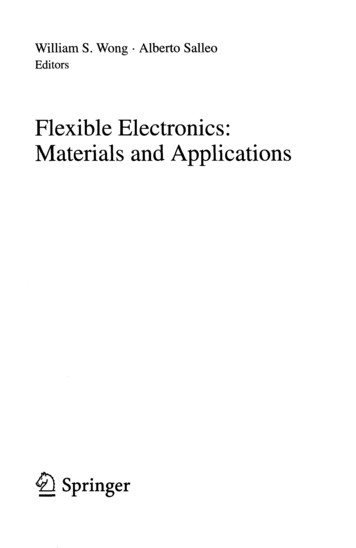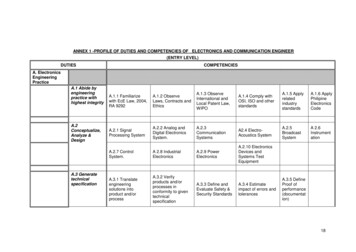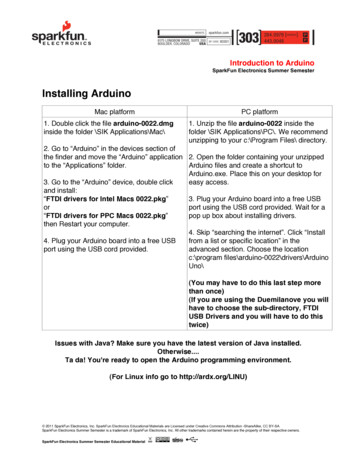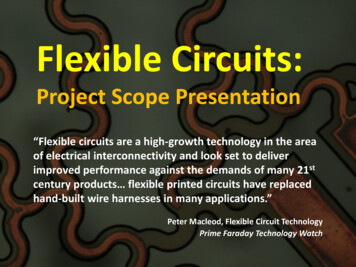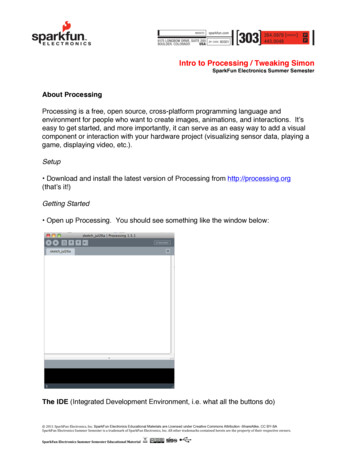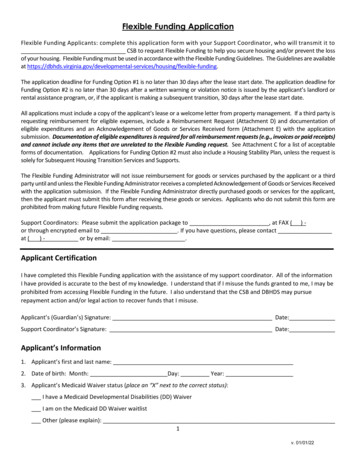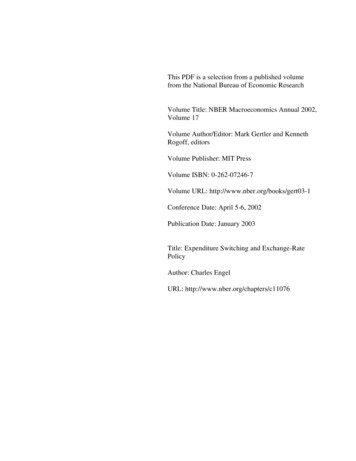
Transcription
Flexible Electronics: Materials and Applications
Electronic Materials: Science and TechnologySeries Editor:Harry L. TullerProfessor of Materials Science and EngineeringMassachusetts Institute of TechnologyCambridge, Massachusettstuller@mit.eduFlexible Electronics: Materials and ApplicationsWilliam S. Wong and Alberto Salleo, eds.ISBN 978-0-387-74362-2, 2009Nanocomposites: Ionic Conducting Materials and Structural SpectroscopiesPhilippe Knauth and Joop Schoonman, eds.ISBN 978-0-387-33202-4, 2008Electroceramic-Based MEMS: Fabrication-Technology and ApplicationsN. SetterISBN 978-0-387-23310-9, 2005Nanostructured Materials: Selected Synthesis Methods, Properties and ApplicationsPhilippe Knauth and Joop Schoonman, eds.ISBN 978-1-4020-7241-3, 2002Nanocrystalline Metals and Oxides: Selected Properties and ApplicationsPhilippe Knauth and Joop Schoonman, eds.ISBN 978-0-7923-7627-9, 2002High-Temperature Superconductors: Materials, Properties, and ApplicationsRainer WescheISBN 978-0-7923-8386-4, 1999Amorphous and Microcrystalline Silicon Solar Cells: Modeling, Materials and DeviceTechnologyRuud E.I. Schropp and Miro Zeman, eds.ISBN 978-0-7923-8317-8, 1998Microactuators: Electrical, Magnetic, Thermal, Optical, Mechanical, Chemical and SmartStructuresMassood Tabib-Azar,ISBN 978-0-7923-8089-4, 1998Thin Film Ferroelectric Materials and DevicesR. Ramesh, ed.ISBN 978-0-7923-9993-3, 1997Wide-Gap Luminescent Materials: Theory and ApplicationsStanley R. Rotman, ed.ISBN 978-0-7923-9837-0, 1997Piezoelectric Actuators and Ultrasonic MotorsKenji UchinoISBN 978-0-7923-9811-0, 1996
William S. Wong · Alberto SalleoEditorsFlexible Electronics:Materials and Applications123
EditorsWilliam S. WongPalo Alto Research Center3333 Coyote Hill RoadPalo Alto, CA 94304wsw@parc.comISBN 978-0-387-74362-2DOI 10.1007/978-0-387-74363-9Alberto SalleoStanford UniversityDepartment of Materials Science &EngineeringStanford, CA 94305-2205asalleo@stanford.edue-ISBN 978-0-387-74363-9Library of Congress Control Number: PCN applied forc Springer Science Business Media, LLC 2009 All rights reserved. This work may not be translated or copied in whole or in part without the writtenpermission of the publisher (Springer Science Business Media, LLC, 233 Spring Street, New York,NY 10013, USA), except for brief excerpts in connection with reviews or scholarly analysis. Use inconnection with any form of information storage and retrieval, electronic adaptation, computer software,or by similar or dissimilar methodology now known or hereafter developed is forbidden.The use in this publication of trade names, trademarks, service marks and similar terms, even if they arenot identified as such, is not to be taken as an expression of opinion as to whether or not they are subjectto proprietary rights.Printed on acid-free paper.springer.com
PrefaceThe advancement of flexible electronics has spanned the past forty years rangingfrom the development of flexible solar cell arrays made from very thin single-crystalsilicon to flexible organic light-emitting diode displays on plastic substrates. Therecent rapid development of this field has been spurred by the continuing evolution of large-area electronics with applications in flat-panel displays, medical imagesensors, and electronic paper. Many factors contribute to the allure of flexible electronics; they are typically more rugged, lighter, portable, and less expensive to manufacture compared to their rigid substrate counterparts. Demonstrations of flexibleelectronics promise the availability of robust, lightweight, and low-cost electronicsin the near future and this book is arranged to give the reader a survey of the materials that are used to fabricate these devices on flexible media. Subsequent chaptersare organized to provide an overview of the different applications that can be createdwith a wide variety of materials systems. The range of polymeric to inorganic materials encompasses a wide array of performance benchmarks. It is these benchmarksof device characteristics (both electrical and mechanical) and performance, and theprocesses involved to make the device that will ultimately determine the suitableapplications. It is not the intent of this book to give an exhaustive review of thetechnology but rather to provide a starting reference for a wide array of materials andapplications; the chapters presented are also intended to augment existing literaturein the field of flexible electronics.The materials, processes, and applications for flexible electronics cover manydifferent areas and we begin the book with a general overview of the field and theevolution of the technology. The mechanical stability of thin films on foil substratesis an area of active study and the understanding of these characteristics needs tobe developed in order to fabricate multilayer structures with minimum offset inlayer-to-layer alignment (Chapter 2). A review of processing conventional inorganicthin-film materials at low temperatures is given in Chapter 3. The chapter provides an overview of the materials and device characteristics for low-temperaturesilicon-based thin-film dielectrics and semiconductors. Chapter 4 describes howthe understanding of the mechanical stability of thin films on foil substrates andlow-temperature processing of conventional inorganic materials, such as amorphous silicon (a-Si:H), can be used for integration onto low melting point plasticplatforms. These semiconductor materials have already been optimized for flat panelv
viPrefacedisplay applications and the transition to flexible electronics enables integration withorganic light emitters to create applications in flexible emissive displays. The transition metal oxides (TMO) have the potential for creating high-performance thin-filmtransistor (TFT) devices beyond the performance offered by a-Si:H or poly-siliconTFTs. Chapter 5 provides an overview of the TMOs and demonstrates a novelnano-imprint lithography approach that can be used to fabricate flexible backplanesin a roll-to-roll process. Applications towards large-area flexible image sensors areanother active area of research. Chapter 6 reviews ink-jet patterning techniques forfabricating a-Si:H based x-ray image sensors for medical imaging applications andink-jet patterning for all-additive processing of backplane arrays.The development of organic and polymeric materials for flexible electronicsis progressing at a rapid rate with organic semiconductor materials producingdevices that rival the performance of conventional a-Si:H TFTs. Small moleculesemiconductors such as pentacene have been used to make organic TFTs andhave shown performance exceeding silicon-based TFTs. Chapter 7 discusses twoapplications, image sensing and micro-electro-mechanical systems (MEMS), whereorganic materials compete well with silicon-based devices in flexible applications.In Chapter 8, the impact of materials and device physics on device and circuit designis discussed in the context of specific applications (displays and radio-frequencyidentification tags) based on pentacene active layers.The transition to solution processable materials provides a potentially limitlesschoice of flexible electronics applications and processes (Chapter 9). These materials offer low-cost processing capabilities from simple spin casting to jet printingfor device fabrication. The major limitation of the materials system is its relativelylow performance for TFT applications. As these materials continue to improve,the appeal of low fabrication cost is also a catalyst for using polymeric semiconductors in photovoltaic applications. A review of excitonic solar cell propertiesand characteristics is presented in Chapter 11 along with an assessment of theapplications for low-cost large-area power sources based on polymeric “green”technologies (Chapter 12).Nano-scale materials are also suitable for flexible electronic applications. Thesize scale and electrical characteristics of randomly oriented carbon nanotubes(CNTs) mats provide a material that is highly compliant, conductive, and transparent in the visible spectrum. These three attributes give CNTs an advantage foruse as transparent conductors for applications in solar cells and flexible displays(Chapter 10). Finally, none of these materials will have much functionality if asuitable substrate is unavailable. Chapter 13 reviews the characteristics required forflexible platforms for use in electronic applications and the processes and barriermaterials that are required in order to make the plastic films optimal for deviceapplications.Lastly, we would like to thank all the contributing authors for their time and effortin preparing the manuscripts presented in this book. It is the work of these peopleand all the scientist, researchers, and engineers in the field that make the technologyof flexible electronics exciting and challenging. We are also grateful to the Palo Alto
PrefaceviiResearch Center and Stanford University for providing support of the project andthe many colleagues whom we worked with in making this book a reality.Palo Alto, CA, USAJanuary 2009William S. WongAlberto Salleo
Contents1 Overview of Flexible Electronics Technology . . . . . . . . . . . . . . . . . . . . . .I-Chun Cheng and Sigurd Wagner1.1 History of Flexible Electronics . . . . . . . . . . . . . . . . . . . . . . . . . . . . . . .1.2 Materials for Flexible Electronics . . . . . . . . . . . . . . . . . . . . . . . . . . . .1.2.1Degrees of Flexibility . . . . . . . . . . . . . . . . . . . . . . . . . . . . . . .1.2.2Substrates . . . . . . . . . . . . . . . . . . . . . . . . . . . . . . . . . . . . . . . . .1.2.3Backplane Electronics . . . . . . . . . . . . . . . . . . . . . . . . . . . . . .1.2.4Frontplane Technologies . . . . . . . . . . . . . . . . . . . . . . . . . . . .1.2.5Encapsulation . . . . . . . . . . . . . . . . . . . . . . . . . . . . . . . . . . . . .1.3 Fabrication Technology for Flexible Electronics . . . . . . . . . . . . . . . .1.3.1Fabrication on Sheets by Batch Processing . . . . . . . . . . . . .1.3.2Fabrication on Web by Roll-to-Roll Processing . . . . . . . . .1.3.3Additive Printing . . . . . . . . . . . . . . . . . . . . . . . . . . . . . . . . . . .1.4 Outlook . . . . . . . . . . . . . . . . . . . . . . . . . . . . . . . . . . . . . . . . . . . . . . . . . .References . . . . . . . . . . . . . . . . . . . . . . . . . . . . . . . . . . . . . . . . . . . . . . . . . . . . .2 Mechanical Theory of the Film-on-Substrate-Foil Structure:Curvature and Overlay Alignment in Amorphous SiliconThin-Film Devices Fabricated on Free-Standing Foil Substrates . . . . .Helena Gleskova, I-Chun Cheng, Sigurd Wagner, and Zhigang Suo2.1 Introduction . . . . . . . . . . . . . . . . . . . . . . . . . . . . . . . . . . . . . . . . . . . . . .2.2 Theory . . . . . . . . . . . . . . . . . . . . . . . . . . . . . . . . . . . . . . . . . . . . . . . . . . .2.2.1The Built-in Strain εbi . . . . . . . . . . . . . . . . . . . . . . . . . . . . . .2.3 Applications . . . . . . . . . . . . . . . . . . . . . . . . . . . . . . . . . . . . . . . . . . . . . .2.3.1Strain in the Substrate, εs (Td ), and the Film, ε f (Td ),at the Deposition Temperature Td . . . . . . . . . . . . . . . . . . . .2.3.2Strain in the Substrate, εs (Tr ), and the Film, ε f (Tr ),at Room Temperature Tr . . . . . . . . . . . . . . . . . . . . . . . . . . . .2.3.3Radius of Curvature R of the Workpiece . . . . . . . . . . . . . . .2.3.4Strain of the Substrate and the Curvature of theWorkpiece for a Three-Layer Structure . . . . . . . . . . . . . . . .2.3.5Experimental Results for a-Si:H TFTs Fabricated onKapton . . . . . . . . . . . . . . . . . . . . . . . . . . . . . . . . . . . . . . . . . .113358121618181920202029293235363638424647ix
xContents2.4 Conclusions . . . . . . . . . . . . . . . . . . . . . . . . . . . . . . . . . . . . . . . . . . . . . . 50References . . . . . . . . . . . . . . . . . . . . . . . . . . . . . . . . . . . . . . . . . . . . . . . . . . . . . 503 Low-temperature Amorphous and Nanocrystalline SiliconMaterials and Thin-film Transistors . . . . . . . . . . . . . . . . . . . . . . . . . . . . . .Andrei Sazonov, Denis Striakhilev, and Arokia Nathan3.1 Introduction . . . . . . . . . . . . . . . . . . . . . . . . . . . . . . . . . . . . . . . . . . . . . .3.2Low-temperature Amorphous and NanocrystallineSilicon Materials . . . . . . . . . . . . . . . . . . . . . . . . . . . . . . . . . . . . . . . . . .3.2.1Fundamental Issues for Low-temperature Processing . . . . .3.2.2Low-temperature Amorphous Silicon . . . . . . . . . . . . . . . . . .3.2.3Low-temperature Nanocrystalline Silicon . . . . . . . . . . . . . .3.3 Low-temperature Dielectrics . . . . . . . . . . . . . . . . . . . . . . . . . . . . . . . .3.3.1Characteristics of Low-temperature DielectricThin-film Deposition . . . . . . . . . . . . . . . . . . . . . . . . . . . . . . .3.3.2Low-temperature Silicon Nitride Characteristics . . . . . . . .3.3.3Low-temperature Silicon Oxide Characteristics . . . . . . . . .3.4 Low-temperature Thin-film Transistor Devices . . . . . . . . . . . . . . . . .3.4.1Device Structures and Materials Processing . . . . . . . . . . . .3.4.2Low-temperature a-Si:H Thin-Film TransistorDevice Performance . . . . . . . . . . . . . . . . . . . . . . . . . . . . . . .3.4.3Contacts to a-Si:H Thin-film Transistors . . . . . . . . . . . . . . .3.4.4Low-temperature Doped nc-Si Contacts . . . . . . . . . . . . . . .3.4.5Low-temperature nc-Si TFTs . . . . . . . . . . . . . . . . . . . . . . . .3.5 Device Stability . . . . . . . . . . . . . . . . . . . . . . . . . . . . . . . . . . . . . . . . . . .3.6 Conclusions and Future Prospective . . . . . . . . . . . . . . . . . . . . . . . . . .References . . . . . . . . . . . . . . . . . . . . . . . . . . . . . . . . . . . . . . . . . . . . . . . . . . . . .535355555656575757585960616264666770704 Amorphous Silicon: Flexible Backplane and Display Application . . . . 75Kalluri R. Sarma4.1 Introduction . . . . . . . . . . . . . . . . . . . . . . . . . . . . . . . . . . . . . . . . . . . . . . 754.2 Enabling Technologies for Flexible Backplanes and Displays . . . . . 764.2.1Flexible Substrate Technologies . . . . . . . . . . . . . . . . . . . . . . 764.2.2TFT Technologies for Flexible Backplanes . . . . . . . . . . . . . 824.2.3Display Media for Flexible Displays (LCD,Reflective-EP, OLED) . . . . . . . . . . . . . . . . . . . . . . . . . . . . . . 894.2.4Barrier Layers . . . . . . . . . . . . . . . . . . . . . . . . . . . . . . . . . . . . . 904.3Flexible Active Matrix Backplane Requirementsfor OLED Displays . . . . . . . . . . . . . . . . . . . . . . . . . . . . . . . . . . . . . . . . 914.3.1Active Matrix Addressing . . . . . . . . . . . . . . . . . . . . . . . . . . . 924.4 Flexible AMOLED Displays Using a-Si TFT Backplanes . . . . . . . . 954.4.1Backplane Fabrication Using PEN Plastic Substrates . . . . . 954.4.2Flexible OLED Display Fabrication . . . . . . . . . . . . . . . . . . . 984.4.3Flexible AMOLED Display Fabricationwith Thin-film Encapsulation . . . . . . . . . . . . . . . . . . . . . . . . 100
Contentsxi4.5Flexible Electrophoretic Displays Fabricatedusing a-Si TFT Backplanes . . . . . . . . . . . . . . . . . . . . . . . . . . . . . . . . . 1024.6Outlook for Low-Temperature a-Si TFT for FlexibleElectronics Manufacturing . . . . . . . . . . . . . . . . . . . . . . . . . . . . . . . . . . 102References . . . . . . . . . . . . . . . . . . . . . . . . . . . . . . . . . . . . . . . . . . . . . . . . . . . . . 1055 Flexible Transition Metal Oxide Electronics and ImprintLithography . . . . . . . . . . . . . . . . . . . . . . . . . . . . . . . . . . . . . . . . . . . . . . . . . . . 107Warren B. Jackson5.1 Introduction . . . . . . . . . . . . . . . . . . . . . . . . . . . . . . . . . . . . . . . . . . . . . . 1075.2 Previous Work . . . . . . . . . . . . . . . . . . . . . . . . . . . . . . . . . . . . . . . . . . . . 1085.3 Properties of Transistor Materials . . . . . . . . . . . . . . . . . . . . . . . . . . . . 1135.3.1Semiconductors . . . . . . . . . . . . . . . . . . . . . . . . . . . . . . . . . . . . 1135.3.2Dielectrics . . . . . . . . . . . . . . . . . . . . . . . . . . . . . . . . . . . . . . . . 1155.3.3Contact Materials . . . . . . . . . . . . . . . . . . . . . . . . . . . . . . . . . . 1165.4 Device Structures . . . . . . . . . . . . . . . . . . . . . . . . . . . . . . . . . . . . . . . . . . 1175.5 Fabrication on Flexible Substrates . . . . . . . . . . . . . . . . . . . . . . . . . . . . 1195.5.1Imprint Lithography . . . . . . . . . . . . . . . . . . . . . . . . . . . . . . . . 1205.5.2Self-Aligned Imprint Lithography . . . . . . . . . . . . . . . . . . . . 1225.5.3SAIL Transistor Results . . . . . . . . . . . . . . . . . . . . . . . . . . . . . 1265.5.4Summary of Imprint Lithography . . . . . . . . . . . . . . . . . . . . . 1275.6 Flexible TMO Device Results . . . . . . . . . . . . . . . . . . . . . . . . . . . . . . . 1285.7 Future Problems and Areas of Research . . . . . . . . . . . . . . . . . . . . . . . 1335.7.1Carrier Density Control . . . . . . . . . . . . . . . . . . . . . . . . . . . . . 1345.7.2Low-Temperature Dielectrics . . . . . . . . . . . . . . . . . . . . . . . . 1355.7.3Etching of TMO Materials . . . . . . . . . . . . . . . . . . . . . . . . . . . 1355.7.4P-type TMO . . . . . . . . . . . . . . . . . . . . . . . . . . . . . . . . . . . . . . 1365.7.5Stability . . . . . . . . . . . . . . . . . . . . . . . . . . . . . . . . . . . . . . . . . . 1365.7.6Flexure and Adhesion of TMO . . . . . . . . . . . . . . . . . . . . . . . 1375.7.7Flexible Fabrication Method Yields . . . . . . . . . . . . . . . . . . . 1375.8 Summary . . . . . . . . . . . . . . . . . . . . . . . . . . . . . . . . . . . . . . . . . . . . . . . . 138References . . . . . . . . . . . . . . . . . . . . . . . . . . . . . . . . . . . . . . . . . . . . . . . . . . . . . 1396 Materials and Novel Patterning Methods for FlexibleElectronics . . . . . . . . . . . . . . . . . . . . . . . . . . . . . . . . . . . . . . . . . . . . . . . . . . . . 143William S. Wong, Michael L. Chabinyc, Tse-Nga Ng,and Alberto Salleo6.1 Introduction . . . . . . . . . . . . . . . . . . . . . . . . . . . . . . . . . . . . . . . . . . . . . . 1436.2 Materials Considerations for Flexible Electronics . . . . . . . . . . . . . . . 1456.2.1Overview . . . . . . . . . . . . . . . . . . . . . . . . . . . . . . . . . . . . . . . . . 1456.2.2Inorganic Semiconductors and Dielectrics . . . . . . . . . . . . . . 1456.2.3Organic Semiconductors and Dielectrics . . . . . . . . . . . . . . . 1466.2.4Conductors . . . . . . . . . . . . . . . . . . . . . . . . . . . . . . . . . . . . . . . 1496.3 Print-Processing Options for Device Fabrication . . . . . . . . . . . . . . . . 1506.3.1Overview . . . . . . . . . . . . . . . . . . . . . . . . . . . . . . . . . . . . . . . . . 150
xiiContents6.3.2Control of Feature Sizes of Jet-Printed Liquids . . . . . . . . . . 1516.3.3Jet-Printing for Etch-Mask Patterning . . . . . . . . . . . . . . . . . 1536.3.4Methods for Minimizing Feature Size . . . . . . . . . . . . . . . . . 1546.3.5Printing Active Materials . . . . . . . . . . . . . . . . . . . . . . . . . . . . 1566.4 Performance and Characterization of Electronic Devices . . . . . . . . . 1576.4.1Overview . . . . . . . . . . . . . . . . . . . . . . . . . . . . . . . . . . . . . . . . . 1576.4.2Bias Stress in Organic Thin-Film Transistors . . . . . . . . . . . 1586.4.3Nonideal Scaling of Short-Channel Organic TFTs . . . . . . . 1636.4.4Low-Temperature a-Si:H TFT Device Stability . . . . . . . . . . 1656.4.5Low-temperature a-Si:H p–i–n Devices . . . . . . . . . . . . . . . . 1676.5 Printed Flexible Electronics . . . . . . . . . . . . . . . . . . . . . . . . . . . . . . . . . 1706.5.1Overview . . . . . . . . . . . . . . . . . . . . . . . . . . . . . . . . . . . . . . . . . 1706.5.2Digital Lithography for Flexible Image SensorArrays . . . . . . . . . . . . . . . . . . . . . . . . . . . . . . . . . . . . . . . . . . . 1706.5.3Printed Organic Backplanes . . . . . . . . . . . . . . . . . . . . . . . . . . 1726.6 Conclusions and Future Prospects . . . . . . . . . . . . . . . . . . . . . . . . . . . . 176References . . . . . . . . . . . . . . . . . . . . . . . . . . . . . . . . . . . . . . . . . . . . . . . . . . . . . 1767 Sheet-Type Sensors and Actuators . . . . . . . . . . . . . . . . . . . . . . . . . . . . . . . 183Takao Someya7.1 Introduction . . . . . . . . . . . . . . . . . . . . . . . . . . . . . . . . . . . . . . . . . . . . . . 1837.2 Sheet-type Image Scanners . . . . . . . . . . . . . . . . . . . . . . . . . . . . . . . . . . 1847.2.1Imaging Methods . . . . . . . . . . . . . . . . . . . . . . . . . . . . . . . . . . 1857.2.2Device Structure and Manufacturing Process . . . . . . . . . . . 1867.2.3Electronic Performance of Organic Photodiodes . . . . . . . . . 1907.2.4Organic Transistors . . . . . . . . . . . . . . . . . . . . . . . . . . . . . . . . . 1917.2.5Photosensor Cells . . . . . . . . . . . . . . . . . . . . . . . . . . . . . . . . . . 1937.2.6Issues Related to Device Processes: Pixel Stabilityand Resolution . . . . . . . . . . . . . . . . . . . . . . . . . . . . . . . . . . . . 1957.2.7A Hierarchal Approach for Slow Organic Circuits . . . . . . . 1967.2.8The Double-Wordline and Double-Bitline Structure . . . . . . 1967.2.9A New Dynamic Second-Wordline Decoder . . . . . . . . . . . . 1997.2.10 Higher Speed Operation with Lower PowerConsumption . . . . . . . . . . . . . . . . . . . . . . . . . . . . . . . . . . . . . 1997.2.11 New Applications and Future Prospects . . . . . . . . . . . . . . . . 2007.3 Sheet-Type Braille Displays . . . . . . . . . . . . . . . . . . . . . . . . . . . . . . . . . 2017.3.1Manufacturing Process . . . . . . . . . . . . . . . . . . . . . . . . . . . . . . 2017.3.2Electronic Performance of Braille Cells . . . . . . . . . . . . . . . . 2047.3.3Organic Transistor-based SRAM . . . . . . . . . . . . . . . . . . . . . 2107.3.4Reading Tests . . . . . . . . . . . . . . . . . . . . . . . . . . . . . . . . . . . . . 2117.3.5Future Prospects . . . . . . . . . . . . . . . . . . . . . . . . . . . . . . . . . . . 2127.4 Summary . . . . . . . . . . . . . . . . . . . . . . . . . . . . . . . . . . . . . . . . . . . . . . . . 212References . . . . . . . . . . . . . . . . . . . . . . . . . . . . . . . . . . . . . . . . . . . . . . . . . . . . . 213
Contentsxiii8 Organic and Polymeric TFTs for Flexible Displays and Circuits . . . . . 215Michael G. Kane8.1 Introduction . . . . . . . . . . . . . . . . . . . . . . . . . . . . . . . . . . . . . . . . . . . . . . 2158.2 Important Organic TFT Parameters for Electronic Systems . . . . . . . 2168.2.1Field-Effect Mobility . . . . . . . . . . . . . . . . . . . . . . . . . . . . . . . 2168.2.2Threshold Voltage . . . . . . . . . . . . . . . . . . . . . . . . . . . . . . . . . . 2198.2.3Subthreshold Swing . . . . . . . . . . . . . . . . . . . . . . . . . . . . . . . . 2208.2.4Leakage Currents . . . . . . . . . . . . . . . . . . . . . . . . . . . . . . . . . . 2228.2.5Contact Resistance . . . . . . . . . . . . . . . . . . . . . . . . . . . . . . . . . 2228.2.6Capacitances and Frequency Response . . . . . . . . . . . . . . . . 2238.2.7TFT Nonuniformity . . . . . . . . . . . . . . . . . . . . . . . . . . . . . . . . 2258.2.8Bias-Stress Instability and Hysteresis . . . . . . . . . . . . . . . . . . 2258.3 Active Matrix Displays . . . . . . . . . . . . . . . . . . . . . . . . . . . . . . . . . . . . . 2278.3.1Introduction . . . . . . . . . . . . . . . . . . . . . . . . . . . . . . . . . . . . . . . 2278.3.2Liquid Crystal and Electrophoretic Displays . . . . . . . . . . . . 2288.4 Active Matrix OLED Displays . . . . . . . . . . . . . . . . . . . . . . . . . . . . . . . 2368.4.1Introduction . . . . . . . . . . . . . . . . . . . . . . . . . . . . . . . . . . . . . . . 2368.5 Using Organic TFTs for Electronic Circuits . . . . . . . . . . . . . . . . . . . . 2428.5.1Thin-Film Transistor Circuits . . . . . . . . . . . . . . . . . . . . . . . . 2428.5.2Frequency Limitations of OTFTs . . . . . . . . . . . . . . . . . . . . . 2468.5.3Integrated Display Drivers . . . . . . . . . . . . . . . . . . . . . . . . . . . 2478.5.4Radio Frequency Identification Tags . . . . . . . . . . . . . . . . . . 2488.6 Conclusion . . . . . . . . . . . . . . . . . . . . . . . . . . . . . . . . . . . . . . . . . . . . . . . 256References . . . . . . . . . . . . . . . . . . . . . . . . . . . . . . . . . . . . . . . . . . . . . . . . . . . . . 2569 Semiconducting Polythiophenes for Field-Effect TransistorDevices in Flexible Electronics: Synthesis and Structure PropertyRelationships . . . . . . . . . . . . . . . . . . . . . . . . . . . . . . . . . . . . . . . . . . . . . . . . . . 261Martin Heeney and Iain McCulloch9.1 Introduction . . . . . . . . . . . . . . . . . . . . . . . . . . . . . . . . . . . . . . . . . . . . . . 2619.2 Polymerization of Thiophene Monomers . . . . . . . . . . . . . . . . . . . . . . 2649.2.1General Considerations . . . . . . . . . . . . . . . . . . . . . . . . . . . . . 2649.2.2Synthetic Routes for the Preparation of ThiophenePolymers . . . . . . . . . . . . . . . . . . . . . . . . . . . . . . . . . . . . . . . . . 2649.3 Poly(3-Alkylthiophenes) . . . . . . . . . . . . . . . . . . . . . . . . . . . . . . . . . . . . 2739.3.1Electrical Properties . . . . . . . . . . . . . . . . . . . . . . . . . . . . . . . . 2759.3.2Thin-film Device Processing and Morphology . . . . . . . . . . 2769.3.3Doping and Oxidative Stability . . . . . . . . . . . . . . . . . . . . . . . 2779.4 Polythiophene Structural Analogues . . . . . . . . . . . . . . . . . . . . . . . . . . 2799.5 Thienothiophene Polymers . . . . . . . . . . . . . . . . . . . . . . . . . . . . . . . . . . 2869.5.1Poly(Thieno(2,3-b)Thiophenes) . . . . . . . . . . . . . . . . . . . . . . 2869.5.2Poly(Thieno(3,2-b)Thiophenes) . . . . . . . . . . . . . . . . . . . . . . 2889.6 Summary . . . . . . . . . . . . . . . . . . . . . . . . . . . . . . . . . . . . . . . . . . . . . . . . 292References . . . . . . . . . . . . . . . . . . . . . . . . . . . . . . . . . . . . . . . . . . . . . . . . . . . . . 293
xivContents10 Solution Cast Films of Carbon Nanotubes for TransparentConductors and Thin Film Transistors . . . . . . . . . . . . . . . . . . . . . . . . . . . 297David Hecht and George Grüner10.1 Introduction: Nanoscale Carbon for Electronics,the Value Proposition . . . . . . . . . . . . . . . . . . . . . . . . . . . . . . . . . . . . . . 29710.2 Carbon NT Film Properties . . . . . . . . . . . . . . . . . . . . . . . . . . . . . . . . . 29810.2.1 Carbon Nanotubes: The Building Blocks . . . . . . . . . . . . . . . 29810.2.2 Carbon Nanotube Network as an Electronic Material . . . . . 29810.2.3 Electrical and Optical Properties of NT Films . . . . . . . . . . . 30010.2.4 Doping and Chemical Functionalization . . . . . . . . . . . . . . . 30410.3 Fabrication Technologies . . . . . . . . . . . . . . . . . . . . . . . . . . . . . . . . . . . 30510.3.1 Solubilization . . . . . . . . . . . . . . . . . . . . . . . . . . . . . . . . . . . . . 30610.3.2 Deposition . . . . . . . . . . . . . . . . . . . . . . . . . . . . . . . . . . . . . . . . 30610.4 Carbon NT Films as Conducting and OpticallyTransparent Material . . . . . . . . . . . . . . . . . . . . . . . . . . . . . . . . . . . . . . . 30910.4.1 Network Properties: Sheet Conductance and OpticalTransparency . . . . . . . . . . . . . . . . . . . . . . . . . . . . . . . . . . . . . 30910.4.2 Applications: ITO Replacement . . . . . . . . . . . . . . . . . . . . . . 31210.4.3 Challenges and the Path Forward . . . . . . . . . . . . . . . . . . . . . 31210.5 TFTs with Carbon Nanotube Conducting Channels . . . . . . . . . . . . . 31310.5.1 Device Characteristics . . . . . . . . . . . . . . . . . . . . . . . . . . . . . . 31410.5.2 Device Parameters . . . . . . . . . . . . . . . . . . . . . . . . . . . . . . . . . 31610.5.3 Challenges and the Path Forward . . . . . . . . . . . . . . . . . . . . . 32310.6 Conclusions . . . . . . . . . . . . . . . . . . . . . . . . . . . . . . . . . . . . . . . . . . . . . . 324References . . . . . . . . . . . . . . . . . . . . . . . . . . . . . . . . . . . . . . . . . . . . . . . . . . . . . 32511 Physics and Materials Issues of Organic Photovoltaics . . . . . . . . . . . . . . 329Shawn R. Scully and Michael D. McGehee11.1 Introduction . . . . . . . . . . . . . . . . . . . . . . . . . . . . . . . . . . . . . . . . . . . . . . 32911.2 Basic Operation . . . . . . . . . . . . . . . . . . . . . . . . . . . . . . . . . . . . . . . . . . . 32911.2.1 Photocurrent . . . . . . . . . . . . . . . . . . . . . . . . . . . . . . . . . . . . . . 33111.2.2 Dark Current . . . . . . . . . . . . . . . . . . . . . . . . . . . . . . . . . . . . . . 33111.3 Organic and Hybrid Solar Cell Architectures . . . . . . . . . . . . . . . . . . . 33211.4 Materials . . . . . . . . . . . . . . . . . . . . . . . . . . . . . . . . . . . . . . . . . . . . . . . . . 33411.5 Light Absorption . . . . . . . . . . . . . . . . . . . . . . . . . . . . . . . . . . . . . . . . . . 33411.6 Exciton Harvesting . . . . . . . . . . . . . . . . . . . . . . . . . . . . . . . . . . . . . . . . 33811.6.1 Effects of Disorder . . . . . . . . . . . . . . . . . . . . . . . . . . . . . . . . . 34011.6.2 Extrinsic Defects . . . . . . . . . . . . . . . . . . . . . . . . . . . . . . . . . . . 34411.6.3 Measuring Exciton Harvesting . . . . . . . . . . . . . . . . . . . . . . . 34411.6.4 Approaches to Overcome Small Diffusion Lengths . . . . . . 34711.7 Exciton Dissociation . . . . . . . . . . . . . . . . . . . . . . . . . . . . . . . . . . . . . . . 34911.8 Dissociating Geminate Pairs . . . . . . . . . . . . . . . . . . . . . . . . . . . . . . . . . 35111.9 Heterojunction Energy Offsets . . . . . . .
Electronic Materials: Science and Technology Series Editor: Harry L. Tuller Professor of Materials Science and Engineering Massachusetts Institute of Technology Cambridge, Massachusetts tuller@mit.edu Flexible Electronics: Materials and Applications William S. Wong and Alberto Salleo, eds. ISBN 978--387-74362-2, 2009
